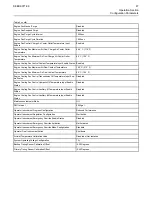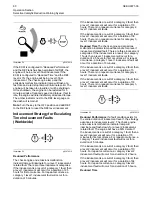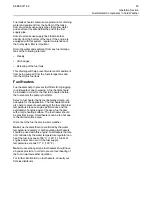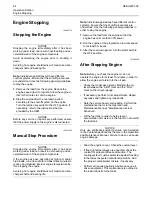
NOTICE
Never attempt to start an engine from an external
power source such as electric welding equipment,
which has a voltage that is unsuitable for engine
starting and will damage the electrical system.
For 904D-E28T industrial engines, use a 12 VDC bat-
tery source to start the engine.
For 904D-E36TA industrial engines, ensure that a 12
VDC or 24 VDC battery source is used to start the
engine.
NOTICE
Using a battery source with the same voltage as the
electric starting motor. Use ONLY equal voltage for
jump starting. The use of higher voltage will damage
the electrical system.
Do not reverse the battery cables. The alternator can
be damaged. Attach ground cable last and remove
first.
Turn all electrical accessories OFF before attaching
the jump start cables.
Ensure that the main power switch is in the OFF posi-
tion before attaching the jump start cables to the en-
gine being started.
1.
Turn the start switch on the stalled engine to the
OFF position. Turn off all the engines accessories.
2.
Connect one positive end of the jump-start cable to
the positive cable terminal of the discharged
battery. Connect the other positive end of the
jump-start cable to the positive cable terminal of
the electrical source.
3.
Connect one negative end of the jump-start cable
to the negative cable terminal of the electrical
source. Connect the other negative end of the
jump-start cable to the engine block or to the
chassis ground. This procedure helps to prevent
potential sparks from igniting the combustible
gases that are produced by some batteries.
Note:
The engine ECM must be powered before the
starting motor is operated or damage can occur.
4.
Start the engine in the normal operating
procedure. Refer to this Operation and
Maintenance Manual, “Starting the Engine”.
5.
Immediately after the engine is started, disconnect
the jump-start cables in reverse order.
After jump starting, the alternator may not be able to
recharge fully batteries that are severely discharged.
The batteries must be replaced or charged to the
proper voltage with a battery charger after the engine
is stopped. Many batteries which are considered
unusable are still rechargeable. Refer to Operation
and Maintenance Manual, “Battery - Replace” and
Testing and Adjusting Manual, “Battery - Test”.
i05359363
After
Starting
Engine
Note:
In
temperatures
from
0
to
60°C
(32
to
140°F),
the
warm-up
time
is
approximately
3
minutes.
In
temperatures
below
0°C
(32°F),
additional
warm-up
time
may
be
required.
When
the
engine
is
idling
during
warm-up,
observe
the
following
conditions:
• Check for fluid or air leaks at idle rpm and at one-
half full rpm (no load on the engine) before
operating the engine under load. Operating the
engine at idle and at one-half full rpm with no load
is not possible in some applications.
• Operate the engine at low idle until all systems
achieve operating temperatures. Check all gauges
during the warm-up period.
Note:
Gauge readings should be observed and the
data should be recorded frequently while the engine
is operating. Comparing the data over time will help
to determine normal readings for each gauge.
Comparing data over time will also help detect
abnormal operating developments. Significant
changes in the readings should be investigated.
Extended Idle at Cold Ambient
Temperature
The engine may automatically change speeds when
the engine is idling in cold ambient temperatures
(typically less than 0° C (32° F) for extended periods.
The purpose of the automatic speed change is
threefold: to maintain the desired operation of the
NOx reduction system, to maintain the desired
operation of the regeneration system and to keep the
engine coolant warm. The engine speed may rise to
1600 rpm for as long as 20 minutes.
The high exhaust system temperature lamp may
illuminate during extended idling conditions. This
illumination signals that a diesel particulate filter
(DPF) regeneration is in progress. Regenerations
during cold ambient extended idling may only last up
to 10 minutes.
SEBU9071-06
51
Содержание 2206F-E13TA
Страница 126: ......
Страница 128: ...SEBU9071 2020 Perkins Engines Company Limited All Rights Reserved 128 December 2020 ...
















































